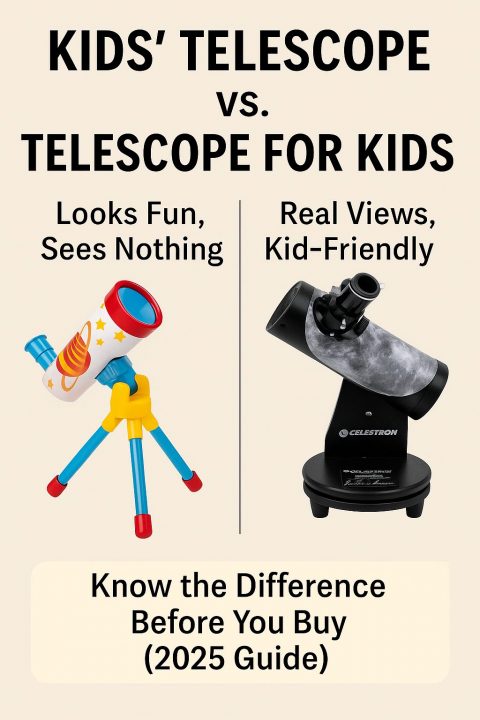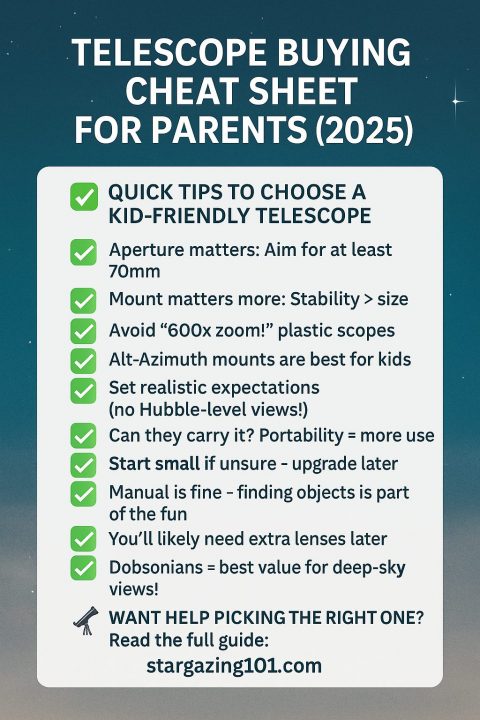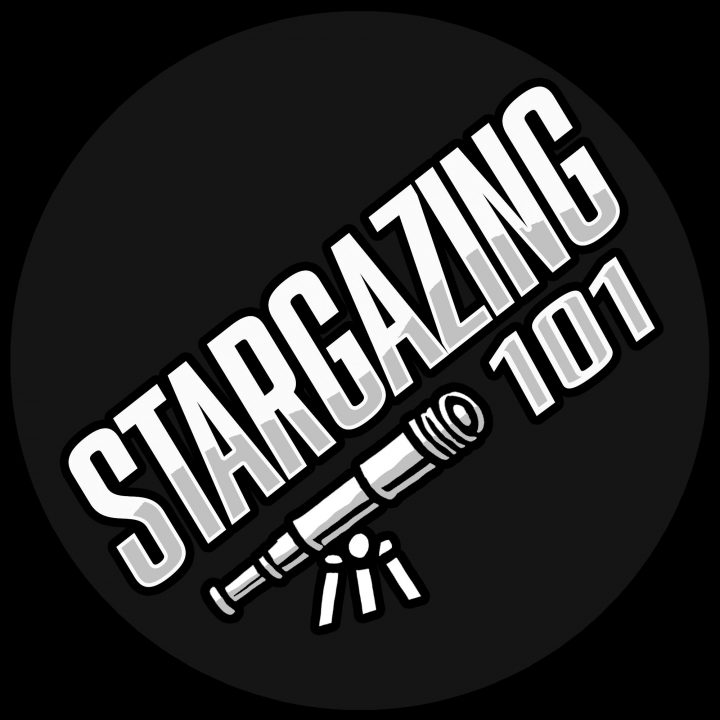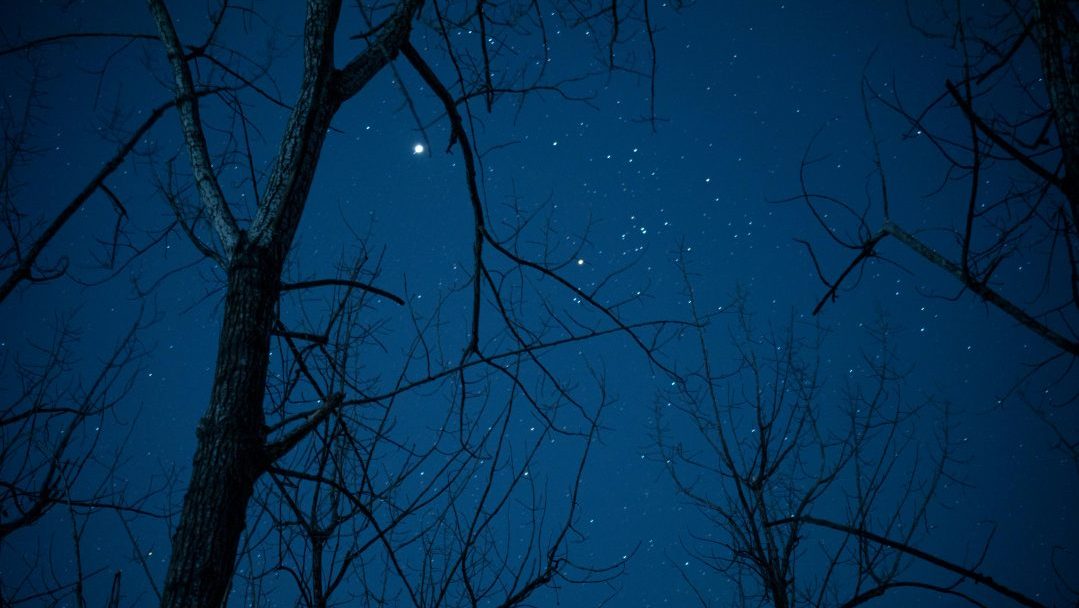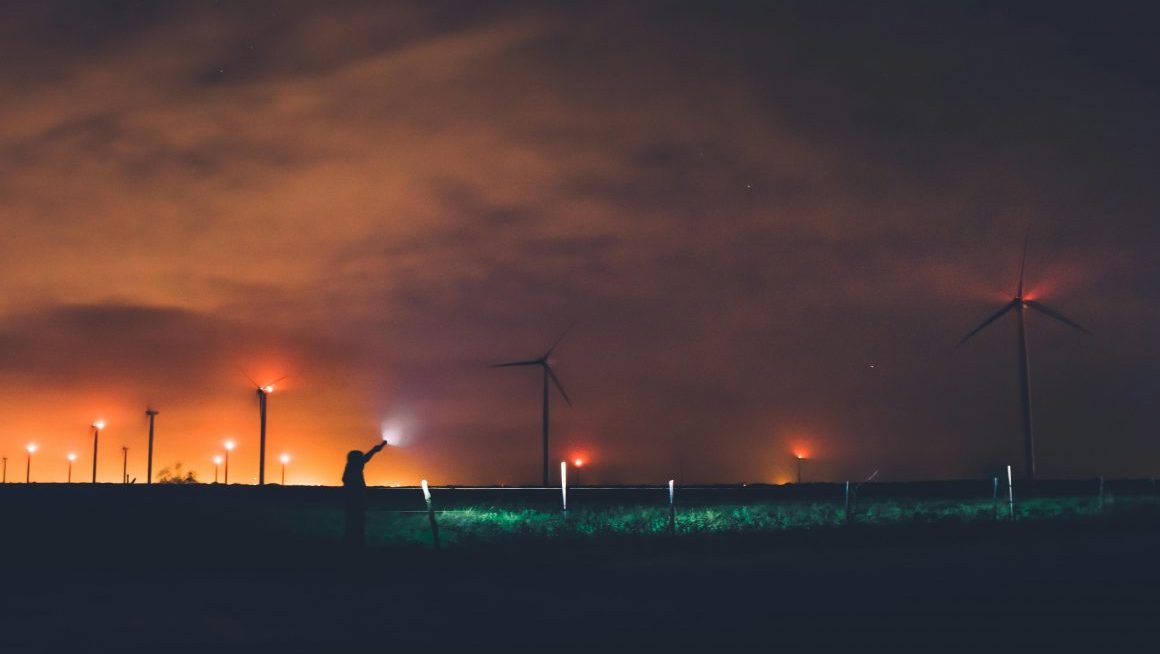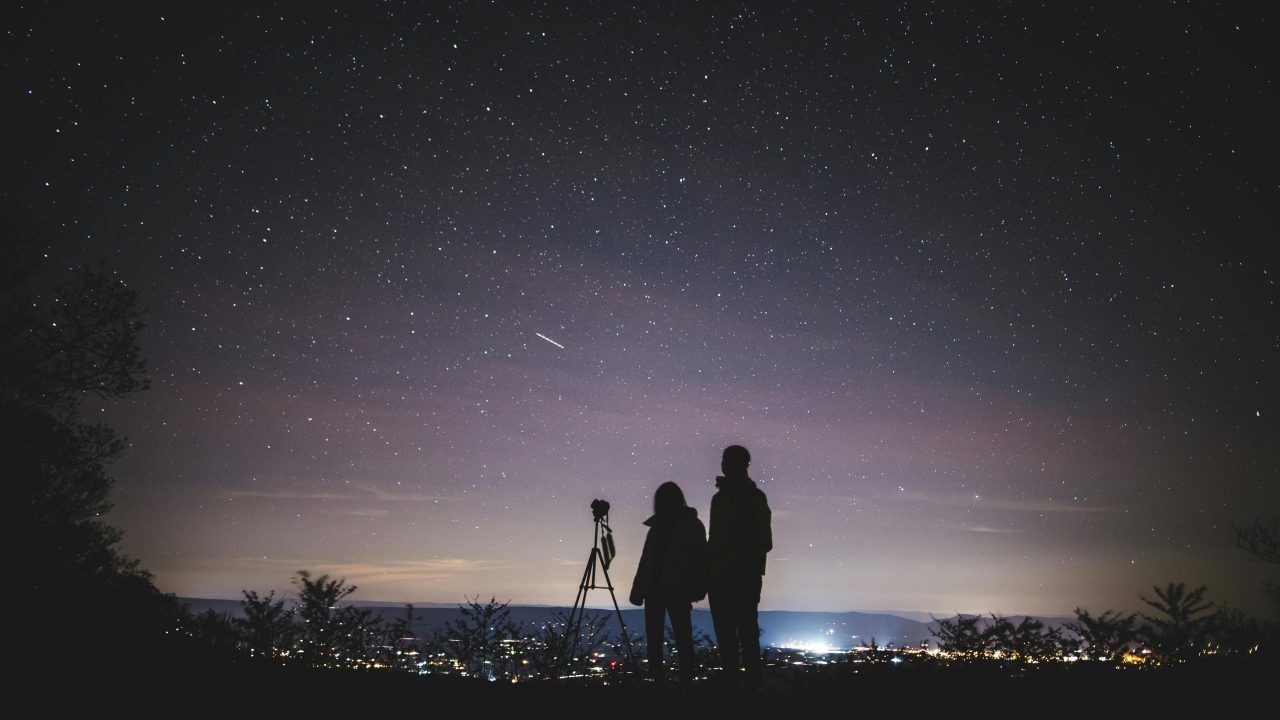Should I Buy My Kid a Telescope?
Short answer: Yes, but not all “kids telescopes” are worth buying.
The majority of telescopes sold as ‘kids telescopes’ at toy stores are mostly junk. Ideally you want to look for an aperture size of at LEAST 70mm with a stable mount.
Not got the time to read this article and just want a low cost option you can get right now?
Then opt for this bad boy:
Celestron Cometron FirstScope 76mm – Often priced below £75/$75
Available on: Amazon UK | Amazon US
It’s a tabletop telescope, so it’s sturdy, super simple to transport and use, and its 76mm aperture makes it a great first telescope.
What You Can See: With the right lenses, you can observe the Moon’s craters, Jupiter’s moons, and bright stars.
Don’t want to scroll? Here are the top notes:
1. Telescope Recommendations for Every Price Point
2. Buy According to Your Budget
–Starter Budget – Under £75/$75
–Small Budget – Under £150/$150
–Mid Budget – Around £250/$350
–Large Budget – Around £350/$450
–X-Large Budget – Around £650/$650
3. What Makes a Telescope Good for Kids?
4. 3 Mistakes to Avoid When Buying a Telescope for Kids
5. Telescope Comparison Table
6. Final Thoughts, Don’t Overthink It
7. Still Stuck? Download the Free PDF Guide
8. About the Author
The reason you’re reading this blog post, and not just heading to a toy store, is because you’re looking for a telescope for kids, but you don’t want a kids telescope.
There’s a big difference.
A kids telescope is usually a plastic toy, often sold in bright colors with big promises and very little functionality. It’s great for make-believe, but not for actually seeing the Moon’s craters or Saturn’s rings. What you’re looking for is a real telescope, one that’s suitable for children, but built like a proper tool: lower-powered, lower-priced, and less complicated than a high-end adult model, yet still capable of sparking wonder and delivering genuine sky views.
The key thing to remember is this: although it’s a child using the telescope, they’re really just a beginner. So instead of searching for “kids telescopes,” the better question is: what are the best telescopes for beginners that are kid-friendly?
That’s exactly what this guide is here to answer.
Buy Kids Telescopes According to Your Budget
Starter Budget Superstar
Under £75 / $75
Celestron Cometron FirstScope 76mm
Aperture: 76mm
Mount: Tabletop Dobsonian
Best For: Young beginners and casual stargazing
What You Can See: With the right lenses, you can observe the Moon’s craters, Jupiter’s moons, and bright stars.
Min. Age: 5+
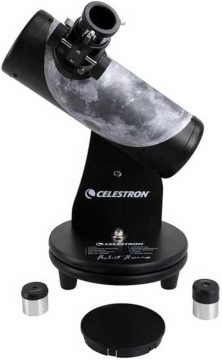
If you want to find a no hassle, no frills, telescope for kids, this is a “dip your toes in” telescope. It’s incredibly affordable, and while the views are basic (think craters on the Moon and Jupiter’s moons) it’s more than enough to spark curiosity. If your child loves the experience, you’ll know it’s worth upgrading later. If not, you haven’t spent a fortune. Expect to upgrade within 6–12 months if interest grows.
Small Budget Choice
Under £150 / $150
Celestron Travel Scope 70 Portable Refractor Telescope (Comes with carry pack)

Aperture: 70mm
Mount: Alt-Azimuth Mount
Best For: Travel and on-the-go observations
What You Can See: With the right lenses, you can observe the Moon’s craters, Jupiter’s moons, and bright stars in the night sky.
Min. Age: 7+
A great portable option for families who want something lightweight and flexible.
It won’t show deep-sky objects in detail, but you’ll catch sharp views of the Moon, bright planets, and wide star fields.
Think of it as a stepping stone, ideal for holidays or garden sessions before committing to a larger setup.
Mid Budget Choice
Around £250/ $350
Celestron StarSense Explorer 114mm Tabletop Dobsonian (Smartphone App-Enabled Telescope)
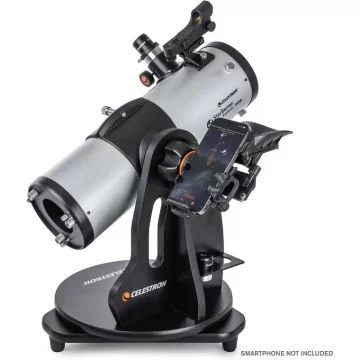
Aperture: 114mm
Mount: Tabletop Dobsonian with Smartphone App Integration
Best For: Teens and tech-savvy beginners
What You Can See: With the right lenses, you can enjoy Saturn’s rings, Jupiter’s cloud belts, and deep-sky objects like the Andromeda Galaxy.
Min. Age: 10+
Now we’re getting serious.
This scope blends app-based guidance with real observational power, letting kids and teens explore Saturn’s rings, Jupiter’s belts, and even galaxies with ease.
It’ll last a few solid years before any serious upgrade is needed, and may just be the one that keeps them hooked for life.
Large Budget Choice
£350+/ $450+
Sky Watcher Heritage 150 Tabletop Dobsonian Telescope
Aperture: 150mm (6 inches)
Focal Length: 750mm (f/5)
Mount: Tabletop Dobsonian Altazimuth
Best For: Intermediate users or families seeking a portable scope with serious light-gathering power
What You Can See: With the right lenses, you can enjoy wide-field views of the Moon, Saturn’s rings, Jupiter’s moons and bands, the Orion Nebula, the Andromeda Galaxy, and more
Min. Age: 10+
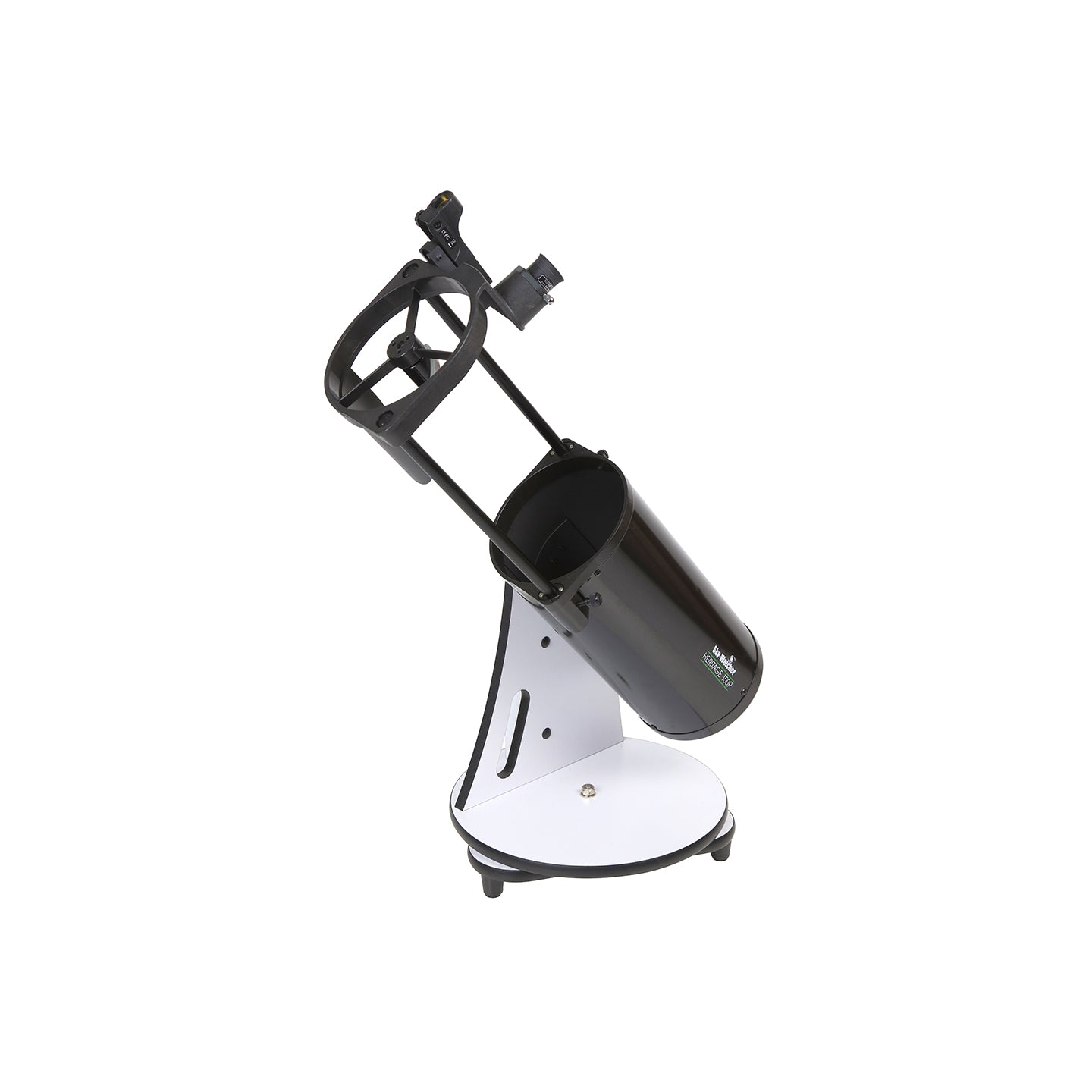
This scope is a powerhouse in a compact body.
It collects enough light to clearly reveal deep-sky objects, nebulae, and planetary detail, perfect for curious minds ready for the next level.
You won’t need to upgrade for a long time unless they go really deep into the hobby. A great family investment.
If you want a compact, yet powerful telescope for kids, the Sky Watcher Heritage 150 Tabletop Dobsonian is a great choice.
Extra Large Budget Option
Around £650 / $650
Sky-Watcher Classic 200 Dobsonian 8-inch Telescope
Aperture: 203mm (8 inches)
Focal Length: 1200mm (f/5.9)
Mount: Dobsonian
Best For: Intermediate to advanced users seeking deep-sky observation capabilities and future proofing
What You Can See: With the right lenses, you can enjoy detailed views of lunar craters, Saturn’s rings, Jupiter’s cloud bands, and deep-sky objects like the Orion Nebula and Andromeda Galaxy
Min. Age: 12+
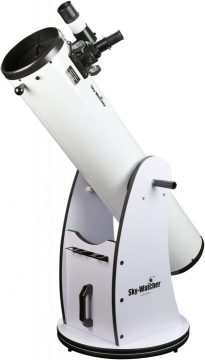
If you’re confident your child (or family) is committed to astronomy, this 8-inch Dobsonian is a future-proof beast. It reveals nearly everything visible from a dark sky with a backyard telescope, lunar craters, planets, nebulae, galaxies, and more.
The only trade-offs? It’s bulky to carry and lacks go-to functionality, meaning you’ll need to aim it manually each time. But inch-for-inch, Dobsonians like this are the most cost-effective way to gather serious light, plus scanning the sky yourself makes the experience far more immersive.
Disclaimer: This is a big telescope, you will most likely need two people to move it around. As such, if you are buying this as a solo person scope, consider that you may not use it as much due to the trouble of moving it around. Trust me, even the best of us get lazy due to the set up complexity of scopes larger than 6-8 inches.
Why the First Telescope Matters More Than You Think
There’s a moment every budding stargazer remembers, the first time they see the Moon up close. The craters look carved, the shadows feel alive, and suddenly space isn’t a distant idea, it’s right there in front of them. They feel like they are in the lunar module, flying the Apollo 11 mission to the moon. That first “wow” moment is magic. It’s the spark that turns curiosity into a lifelong fascination.
Make no mistake, the experience your child has with their first telescope will build memories that last their lifetime.
But the opposite is just as powerful. If the image is blurry, the tripod wobbly, or they can’t find anything but black sky, kids can lose interest fast. And disappointment will be all that they remember. One frustrating night is sometimes all it takes to turn excitement into disappointment and put a stopper in something that could become a lifelong hobby or fascination for them.
What Makes a Telescope Good for Kids?
Aperture Size: Bigger = Better (min. 60–70mm)
Aperture is the diameter of the telescope’s main lens or mirror and determines how much light the telescope can gather.
The more light, the better the view.
For kids, an aperture of at least 60–70mm is where the real magic begins. Anything below that and you’re likely looking at a toy, not a tool. With a proper aperture, you can see the Moon in detail, spot Jupiter’s moons, and even glimpse Saturn’s rings.
Mount stability: Avoid Unstable Tripods
Even a good telescope can feel useless if the mount shakes like jelly every time you touch it. Stable mounting is essential, especially for kids who are still learning to gently adjust and track. Due to the Earth’s rotation, things naturally move across your view point, pretty quickly.
Cheap, flimsy tripods often cause frustration and blurry views. That’s why tabletop Dobsonian mounts are great for younger users: simple, solid, and almost impossible to knock out of alignment.
Simplicity: Alt-Az > EQ for Young Beginners
There are two main types of mounts: Alt-Azimuth (Alt-Az) and Equatorial (EQ).
Alt-Az moves up/down and left/right, like a camera tripod.
EQ mounts require polar alignment and move in arcs that match the Earth’s rotation.
That’s helpful for long exposure photography, but for kids? It’s often just confusing. Alt-Az keeps things intuitive and enjoyable.
Size vs. Portability: Can They Carry it Themselves?
As I previously touched on, a telescope that’s too big and bulky to lift is one that won’t get used often. Portability matters more than you’d think.
If a child (or parent) dreads setting it up, it’ll stay in the cupboard, spare room, or corner of doom.
Smaller tabletop scopes or lightweight models are easier to store, carry, and take out for quick stargazing sessions.
Expectations: What Can They Realistically See?
Even the best starter scopes won’t give Hubble-like views. But they can absolutely reveal the Moon’s craters, Jupiter’s moons, Saturn’s rings, and the Orion Nebula, especially under dark skies.
Knowing what to expect helps avoid disappointment and builds appreciation for what’s actually amazing: looking up and realizing you’re seeing another planet with your own eyes.
Bonus Tip: You Can See Saturn’s Rings from a Backyard – Even Through Smaller Scopes
It’s true, even from a suburban garden, with the right telescope and eyepiece, kids can see Saturn’s rings and Jupiter’s moons.
That experience is often the gateway to a lifelong love of space. And at the very least, a lifelong memory of a special time.
To see the Moon and Jupiter’s moons, you need at least:
- 60–70mm aperture
- 30x–50x magnification
- A sturdy, (non-toy) mount
3 Mistakes to Avoid When Buying a Telescope for Kids
Buying a “600x Magnification” Plastic Telescope
If the box screams “600x magnification!” in giant letters, walk away.
These are almost always toy scopes made with poor optics and shaky mounts. While the idea of super-high zoom sounds exciting, it’s actually counterproductive. Most celestial objects look best at 30x–150x, and anything beyond that usually results in a blurry mess.
Kids need clear views, not crushed expectations.
Choosing Size Over Stability
Big telescopes look impressive, but if they wobble like a spinning plate on a stick, they’ll frustrate a beginner fast.
A smaller scope on a solid mount is always better than a giant one that shakes with every breath of wind.
For kids, stability matters more than size, especially when they’re just learning to aim and focus.
Expecting It to Work Like an iPhone (Instant Results)
Unless you are planning on buying a Smart Telescope like the Seestar S50 Smart Digital Telescope Available on: Amazon UK | Amazon US which is a pretty hands off way to get some great visuals… telescopes don’t come with “auto-detect sky” buttons.
Even with app assistance, stargazing takes patience, trial, and error, which is part of the magic.
Expecting plug-and-play performance can lead to disappointment.
That’s why it’s so important to help kids treat the telescope like a tool of discovery, not a toy with a start button. The journey of learning how to use it is half the joy.
Best Telescopes by Age Group
This is a vague recommendation, because some kids will be further along than others, or have more knowledge, but as a rule of thumb:
Ages 4–7 → Celestron Firstscope.
A great entry point for the youngest stargazers. It’s lightweight, simple to use, and perfect for short backyard sessions focused on the Moon and bright stars.
Ages 8–12 → Celestron Travel Scope 70, StarSense Explorer 114mm, or with initial adult supervision and guidance, Sky-Watcher Heritage 150p.
This tabletop Dobsonian offers a serious upgrade in viewing power while remaining compact and beginner-friendly. Ideal for curious kids ready to explore planets and bright deep-sky objects.
Teens → Realistically StarSense Explorer 114mm, Sky-Watcher Heritage 150p, or the super powerful Sky-Watcher Classic 200P.
For older kids and teens who love tech, this scope’s smartphone-assisted navigation makes it easy to find galaxies, nebulae, and planets. It’s fun, modern, and great for building independence.
Best Telescopes for Kids – Table
| Model | Best For | Aperture | Mount | Age | Where to Buy |
| Celestron FirstScope 76mm | Young kids and casual use | 76mm | Tabletop Dobsonian | 5+ | Available on: Amazon UK | Amazon US |
| Celestron Travel Scope 70 | Lightweight travel, early learners | 70mm | Altazimuth Tripod | 7+ | Available on: Amazon UK | Amazon US |
| StarSense Explorer 114mm | Tech-savvy teens, assisted finding | 114mm | Tabletop Dobsonian | 10+ | Available on: Amazon UK | Amazon US |
| Sky-Watcher Heritage 150p | Families and intermediate hobbyists | 150mm | Tabletop Dobsonian | 10+ | Available on: Amazon UK | Amazon US |
| Sky-Watcher Classic 200P | Advanced beginners, deep-sky views | 200mm | Full-size Dobsonian | 12+ | Available on: Amazon UK | Amazon US |
Final Thoughts, Don’t Overthink It
Buying your first telescope can feel overwhelming, there are so many models, specs, and opinions.
But here’s the truth:
The view matters more than the brand.
Your child probably won’t remember the telescope’s make or model. But they will remember the first time they saw Saturn’s rings or the Moon’s craters with their own eyes. And that memory starts with a scope that’s easy to use, stable, and good enough to spark wonder.
So don’t get caught up chasing “the perfect one.”
Start with something simple.
If they love it, you can always upgrade later.
Enjoyed this post? If you’d like to support the creation of more beginner-friendly guides and tools, you can buy me a coffee. It means a lot. ☕
Still not sure which kids telescope is right for you?
Download the free PDF guide below, it breaks everything down by what to expect, budget, and goals in one easy-to-follow PDF guide.
Free PDF: Choosing Your First (or Next) Telescope
Choosing your first telescope doesn’t have to be overwhelming.
Inside this free guide, you’ll discover how to:
- Buy with confidence by understanding which telescope fits your goals
- Save time, money, and stress by avoiding beginner mistakes
- See craters, moons, and nebulae clearly with the right eyepieces
- Choose a scope that fits your life—not just your budget
- Shop smarter using a printable checklist you can take with you
Tell us where to send it, and we’ll email you the full PDF now:
Telescopes for Kids FAQ Section
What age is best to start stargazing?
Kids as young as 4–5 can enjoy stargazing with help from an adult. The key is to keep it short, fun, and focused on bright, easy-to-see objects like the Moon or Jupiter’s moons.
Can you see Saturn with a kids telescope?
Yes! Even a small telescope (60–70mm) with the right lens can show Saturn’s rings, though they’ll appear small. Bigger apertures (100mm+) reveal more detail like the Cassini Division.
How hard is it to use a Dobsonian?
Not hard at all. Dobsonians are actually some of the easiest telescopes to use, especially for beginners. They move up/down and left/right, just point and look. No complicated setup.
Do I need to buy extra lenses?
Most telescopes come with 1–2 eyepieces. You can start with those, but eventually upgrading to a higher-quality lens (and maybe a Barlow lens) will enhance your views dramatically.
If you want a rough guide of which lenses to consider upgrading to in the future, why not check out our free eyepiece calculation tool?
Simply enter the scopes focal length and aperture, and it’ll provide you with customized lens recommendations.
You can try the tool here: Stargazing101 Eyepiece Tool
Tip #3
"Saturn’s rings are visible with as little as 30x magnification, even a small telescope can reveal them clearly."
-Tip #3


